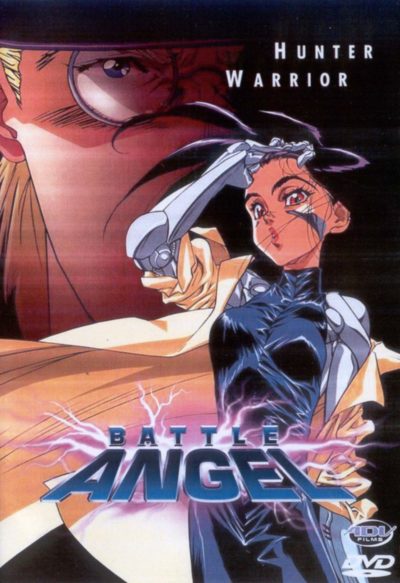★★★½
“Sweet, yet too short.”
 Watching this after having read the manga version, it feels like the anime version can do little more than scratch the surface of the world of Tiphares, in the barely fifty minutes it has to work with across its two OVA (Original Video Animation) volumes. The stories here, originally released in 1993, cover the first two section of the manga, and it looks like much of what we see here will also be included in the live-action film next February. Slightly confusing matters, is the way this uses the original Japanese names. So Tiphares becomes Zalem here, and Hugo is Yugo. Most oddly, the heroine is not called Alita – hence the absence of her name from the title – but Gally. To avoid further confusion, I’m going to be consistent with our other articles on the topic, and stick to the translated ones for what follows.
Watching this after having read the manga version, it feels like the anime version can do little more than scratch the surface of the world of Tiphares, in the barely fifty minutes it has to work with across its two OVA (Original Video Animation) volumes. The stories here, originally released in 1993, cover the first two section of the manga, and it looks like much of what we see here will also be included in the live-action film next February. Slightly confusing matters, is the way this uses the original Japanese names. So Tiphares becomes Zalem here, and Hugo is Yugo. Most oddly, the heroine is not called Alita – hence the absence of her name from the title – but Gally. To avoid further confusion, I’m going to be consistent with our other articles on the topic, and stick to the translated ones for what follows.
We see Ido (Kariya) discover the head of Alita (Itou), and almost before we can blink, it’s back to being fully functioning. He’s a part-time cyber-doctor, part-time bounty-hunter, and after Alita follows him – suspecting he’s a killer who is stalking the streets of the scrapyard – she ends up rescuing him from the real killer. She also meets and falls for Hugo (Yamaguchi), a young man desperate to get out of the scrapyard, by any means necessary – a fact that proves to be the source of his downfall in the second OAV. Not present in the manga is the character of Chiren (Koyama). Like Ido, she’s a refugee from Tiphares, who resent his cyber-medical skills and wants to prove herself superior. To do so, she rescues gladiator Grewcica and sets him against Ido’s creation, Alita.
For something a quarter-century old, the animation has stood the test of time well. This is notable in the first part, and especially the battles between Alita and Grewcica, which remain more than capable of getting the blood pumping. The look of the scrapyard and Tiphares have been transferred nicely. The colours feel like your imagination told you they should, from the b&w manga, and even the sound design adds to the atmosphere, both in Kaoru Wada’s score and the groans of the pipes connecting Tiphares to the scrap-yard.
The problem, I think, is a script which doesn’t have enough room to develop the characters and their interactions. Especially short-changed is the relationship between Alita and Hugo, which feels like it goes from zero to passionate love (on her side, at least) in no time at all. As a result, you’re left to wonder why she’s prepared to go to such lengths for him, though his eventual fate remains poignant – not least the addition of a little flourish at the end, where Ido and Alita send up a balloon in his honour. I probably would have felt kinder towards these episodes if I’d seen them before reading the original source material; as is, while solid enough, I can’t help feeling there’s something missing.
Dir: Hiroshi Fukutomi
Star (voice): Miki Itou, Shunsuke Kariya, Kappei Yamaguchi, Mami Koyama




